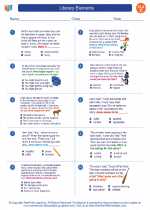Verbs
Verbs are words that show action, occurrence, or state of being. They are an essential part of any sentence. Verbs can be classified into three main categories: action verbs, linking verbs, and helping verbs.
Action Verbs
Action verbs express physical or mental action. They answer the question "What is the subject doing?" For example:
- She ran to the store.
- They think carefully before making a decision.
Linking Verbs
Linking verbs connect the subject of a sentence to a noun or an adjective that renames or describes the subject. Common linking verbs include "am," "is," "are," "was," "were," "seem," "become," and "appear." For example:
- She is a doctor.
- The flowers smell lovely.
Helping Verbs
Helping verbs, also known as auxiliary verbs, are used with main verbs to express shades of time and mood. They help to form tenses, questions, and negative statements. Examples of helping verbs include "be," "have," "do," "can," "may," "must," and "should." For example:
- I am studying for my exam.
- They have finished their homework.
Study Guide for Verbs
Here are some tips for studying verbs:
- Identify the verb in a sentence by asking "What is the subject doing?" for action verbs, or "What does the subject exist as?" for linking verbs.
- Be familiar with the various forms of verbs, including past, present, and future tenses.
- Practice conjugating verbs in different tenses and moods.
- Understand the role of helping verbs in forming different verb tenses and moods.
- Use verbs in context by writing sentences and stories that incorporate a variety of verb types.
Understanding verbs is crucial for constructing meaningful and grammatically correct sentences. By mastering the different types of verbs and their usage, you can enhance your writing and communication skills.
[Verbs] Related Worksheets and Study Guides:
.◂English Language Arts Worksheets and Study Guides Third Grade. Literary Elements

 Worksheet/Answer key
Worksheet/Answer key
 Worksheet/Answer key
Worksheet/Answer key
